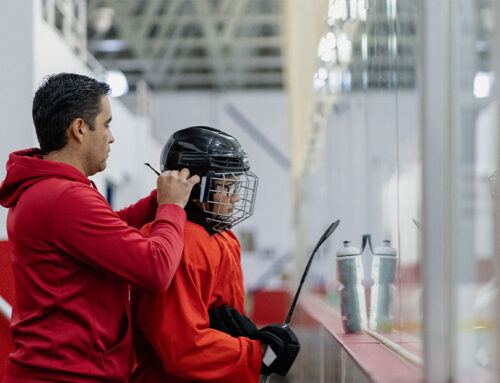Practical Recruiting Tips for High School Athletes
You’ve played your sport since you were a little kid, and you’re pretty good at it. Now it’s time for you to think about playing in college. You might even think about the possibility of getting a scholarship, but you’re not quite sure how to go about it.
You’ve heard all kinds of stories from your friends and you are not sure what to believe. This much I can tell you: Preparing for college is a stressful time for you and your family. Add in trying to get an athletic scholarship, and the stress is compounded many times over.
Here are some tips to make the recruiting process easier for you and your family.
1. Consider a camp.
When choosing a college, be realistic with your expectations. If you are good enough to play for a Division I school, chances are a school will have already seen you and contacted you or your coach to express interest. But, that’s not the only way into a top program.
A great way to get on a school’s radar is to attend a summer camp for your sport at that school. If you have a good showing at camp, you will create interest. The college coaches will hopefully watch you during your upcoming season. The best time to use this approach is after your junior year. That gives the college coaches your full senior year to track you on their recruiting board.
I am not a huge fan of showcases or random camps, because most of them are just money makers with few true opportunities. Be wary of them; they are expensive, and you may waste your money.
Coaches don’t put too much stock in a set of scores from these camps either. They know a 4.4-second 40 may not be accurate, especially if you are paying for it. Colleges will time you and weigh you and record all the other stats they need when they meet you in the proper situations. Those are the stats they will use.
2. Keep your highlight tape short and sweet.
Another tip many of you know but may be going about it the wrong way is sending a highlight tape. Many of you have YouTube channels featuring your highlights.
Athletes often make their highlight tapes too long. A coach may receive clips from 50 to 60 athletes a week. If each one was 10 minutes long, coaches would have to spend all day watching tape—most of which would be of athletes they will not select for their programs.
Try to keep your highlights to three minutes. Coaches know quickly if they have interest or not. If they are interested, they will know how to proceed with you. Also, balance your tape. Let’s say you’re a linebacker. Show some hard hits, but also show some downfield pursuit to showcase your speed—and some clips of you dropping into coverage. Add some lateral movement clips and some turnovers if you have them—and, of course, your big hits.
Three to three-and-a-half minutes are all you need. Think about it. If each clip is six seconds, that’s 10 per minute. Thirty highlights in three minutes is plenty for a coach to make a decision on whether he wants to see more.
3. Keep your grades up.
We’ve all heard stories about guys who could barely read or write, yet they got into a top school, were sheltered by instructors and graduated—just so they could play a sport. Total B.S.—It does not happen that way. Maybe it once did—I have never seen it personally—but I can tell you this for sure:
The NCAA has strict regulations, and schools have compliance departments regarding students’ grade point averages. Colleges do not play games. If you do not meet the requirements, you are out of luck. You may get probation, but that may make you academically ineligible. If your grades are borderline in high school, coaches will be reluctant to take a chance on you. And why should they? There are probably many other less risky options for them.
Most colleges offer academic assistance programs, but only after you have been accepted. The high school part is up to you. A 2.7 GPA is about the bare minimum to most colleges—and if your GPA is that low, you’d better be a top athlete.
We all know how important the SAT is, so I recommend a prep course to help you with that. A low SAT score is another red flag to a coach. It indicates that you may be a little lazy and that you don’t put in the effort needed to achieve a satisfactory score—but, hey, it’s your choice.
4. Make sure your training is consistent and balanced.
You must work on your strength, but you must also work on speed and biomechanics. My advice is to get to an actual training center that can help you. Chances are your high school coach is not your best avenue for advanced training. Not that he or she does not mean well, but high school coaches might not have as much knowledge as a speed and strength center coach does.
5. Look at several schools at different levels.
There is nothing wrong with a junior college or a D-III school. In fact, you will probably enjoy it as much as a big school. If you are an athlete and you want to play a sport, go to a school where you will actually play. Most top schools have players three-deep at your position and will not look to you for three or four years. You may not want to go that route. I don’t know many athletes who enjoy sitting on the bench.
Pick a school you will like even if you decide not to play or if you get hurt. You still want to enjoy your college experience. College sports is only one piece of it, so choose wisely with that in mind.
Remember, college coaches, switch colleges often. It’s part of the business. Base your decision on a complete scenario, not simply because you like a coach. There is a good chance you may have a different coach when you graduate than when you start.
RECOMMENDED FOR YOU
MOST POPULAR
Practical Recruiting Tips for High School Athletes
You’ve played your sport since you were a little kid, and you’re pretty good at it. Now it’s time for you to think about playing in college. You might even think about the possibility of getting a scholarship, but you’re not quite sure how to go about it.
You’ve heard all kinds of stories from your friends and you are not sure what to believe. This much I can tell you: Preparing for college is a stressful time for you and your family. Add in trying to get an athletic scholarship, and the stress is compounded many times over.
Here are some tips to make the recruiting process easier for you and your family.
1. Consider a camp.
When choosing a college, be realistic with your expectations. If you are good enough to play for a Division I school, chances are a school will have already seen you and contacted you or your coach to express interest. But, that’s not the only way into a top program.
A great way to get on a school’s radar is to attend a summer camp for your sport at that school. If you have a good showing at camp, you will create interest. The college coaches will hopefully watch you during your upcoming season. The best time to use this approach is after your junior year. That gives the college coaches your full senior year to track you on their recruiting board.
I am not a huge fan of showcases or random camps, because most of them are just money makers with few true opportunities. Be wary of them; they are expensive, and you may waste your money.
Coaches don’t put too much stock in a set of scores from these camps either. They know a 4.4-second 40 may not be accurate, especially if you are paying for it. Colleges will time you and weigh you and record all the other stats they need when they meet you in the proper situations. Those are the stats they will use.
2. Keep your highlight tape short and sweet.
Another tip many of you know but may be going about it the wrong way is sending a highlight tape. Many of you have YouTube channels featuring your highlights.
Athletes often make their highlight tapes too long. A coach may receive clips from 50 to 60 athletes a week. If each one was 10 minutes long, coaches would have to spend all day watching tape—most of which would be of athletes they will not select for their programs.
Try to keep your highlights to three minutes. Coaches know quickly if they have interest or not. If they are interested, they will know how to proceed with you. Also, balance your tape. Let’s say you’re a linebacker. Show some hard hits, but also show some downfield pursuit to showcase your speed—and some clips of you dropping into coverage. Add some lateral movement clips and some turnovers if you have them—and, of course, your big hits.
Three to three-and-a-half minutes are all you need. Think about it. If each clip is six seconds, that’s 10 per minute. Thirty highlights in three minutes is plenty for a coach to make a decision on whether he wants to see more.
3. Keep your grades up.
We’ve all heard stories about guys who could barely read or write, yet they got into a top school, were sheltered by instructors and graduated—just so they could play a sport. Total B.S.—It does not happen that way. Maybe it once did—I have never seen it personally—but I can tell you this for sure:
The NCAA has strict regulations, and schools have compliance departments regarding students’ grade point averages. Colleges do not play games. If you do not meet the requirements, you are out of luck. You may get probation, but that may make you academically ineligible. If your grades are borderline in high school, coaches will be reluctant to take a chance on you. And why should they? There are probably many other less risky options for them.
Most colleges offer academic assistance programs, but only after you have been accepted. The high school part is up to you. A 2.7 GPA is about the bare minimum to most colleges—and if your GPA is that low, you’d better be a top athlete.
We all know how important the SAT is, so I recommend a prep course to help you with that. A low SAT score is another red flag to a coach. It indicates that you may be a little lazy and that you don’t put in the effort needed to achieve a satisfactory score—but, hey, it’s your choice.
4. Make sure your training is consistent and balanced.
You must work on your strength, but you must also work on speed and biomechanics. My advice is to get to an actual training center that can help you. Chances are your high school coach is not your best avenue for advanced training. Not that he or she does not mean well, but high school coaches might not have as much knowledge as a speed and strength center coach does.
5. Look at several schools at different levels.
There is nothing wrong with a junior college or a D-III school. In fact, you will probably enjoy it as much as a big school. If you are an athlete and you want to play a sport, go to a school where you will actually play. Most top schools have players three-deep at your position and will not look to you for three or four years. You may not want to go that route. I don’t know many athletes who enjoy sitting on the bench.
Pick a school you will like even if you decide not to play or if you get hurt. You still want to enjoy your college experience. College sports is only one piece of it, so choose wisely with that in mind.
Remember, college coaches, switch colleges often. It’s part of the business. Base your decision on a complete scenario, not simply because you like a coach. There is a good chance you may have a different coach when you graduate than when you start.
RECOMMENDED FOR YOU
Create A Free Recruiting Profile Today!
CaptainU helps athletes & parents not only be proactive but also to manage and take control of their entire recruiting journey.










